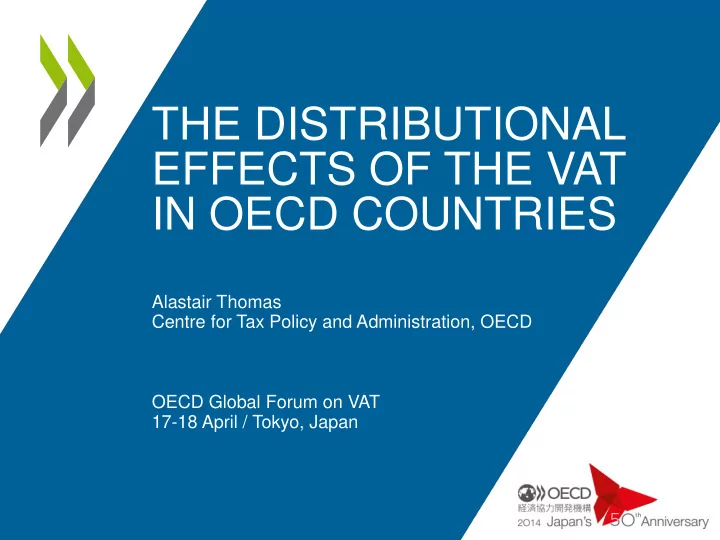

THE DISTRIBUTIONAL EFFECTS OF THE VAT IN OECD COUNTRIES Alastair Thomas Centre for Tax Policy and Administration, OECD OECD Global Forum on VAT 17-18 April / Tokyo, Japan
Outline of presentation • Methodology – Non-behavioural micro-simulation • Results – Part 1: Distributional analysis across income and expenditure deciles – Part 2: Effectiveness of reduced VAT rates – Part 3: Simulation of hypothetical reforms 2
Methodology • Micro-simulation based on household expenditure survey micro-data • 20 countries (most data is for 2010). • Key assumption/limitation: – No behavioural responses 3
Part 1: Distributional results (20-country averages) % % VAT/income VAT/expenditure VAT/income VAT/expenditure 16% 16% 14% 14% 12% 12% 10% 10% 8% 8% 6% 6% 4% 4% 2% 2% 0% 0% Income deciles Expenditure deciles 4
Part 2: Effectiveness of reduced rates • Simulate an increase in all zero and reduced VAT rates to the level of the standard rate. • For each reduced rate, calculate the average “tax expenditure” per household: – i.e. the difference between simulated revenue at the standard rate and at the reduced rate. 5
Group 1: Reduced rates directly aimed at supporting poor households 6
All-country average tax expenditure from reduced rates on food (16 countries) EUR EUR Aggregate % of expenditure Aggregate % of expenditure 1,400 5% 1,400 5% 1,200 1,200 4% 4% 1,000 1,000 3% 3% 800 800 600 600 2% 2% 400 400 1% 1% 200 200 0 0% 0 0% Income deciles Expenditure deciles 7
All-country average tax expenditure from reduced rates on water (9 countries) EUR EUR Aggregate % of expenditure Aggregate % of expenditure 60 0.40% 60 0.40% 0.35% 0.35% 50 50 0.30% 0.30% 40 40 0.25% 0.25% 30 0.20% 30 0.20% 0.15% 0.15% 20 20 0.10% 0.10% 10 10 0.05% 0.05% 0 0.00% 0 0.00% Income deciles Expenditure deciles 8
All-country average tax expenditure from reduced rates on children’s clothing and shoes (5 countries) EUR EUR Aggregate % of expenditure Aggregate % of expenditure 60 0.30% 60 0.30% 50 0.25% 50 0.25% 40 0.20% 40 0.20% 30 0.15% 30 0.15% 20 0.10% 20 0.10% 10 0.05% 10 0.05% 0 0.00% 0 0.00% Income deciles Expenditure deciles 9
Group 2: Reduced rates intended to support cultural activities and social goods 10
All-country average tax expenditure from reduced rates on books (18 countries) EUR EUR Aggregate % of expenditure Aggregate % of expenditure 60 0.12% 60 0.12% 50 0.10% 50 0.10% 40 0.08% 40 0.08% 30 0.06% 30 0.06% 20 0.04% 20 0.04% 10 0.02% 10 0.02% 0 0.00% 0 0.00% Income deciles Expenditure deciles 11
All-country average tax expenditure from reduced rates on newspapers and periodicals (17 countries) EUR EUR Aggregate % of expenditure Aggregate % of expenditure 60 0.12% 60 0.12% 50 0.10% 50 0.10% 40 0.08% 40 0.08% 30 0.06% 30 0.06% 20 0.04% 20 0.04% 10 0.02% 10 0.02% 0 0.00% 0 0.00% Income deciles Expenditure deciles 12
All-country average tax expenditure from reduced rates on cinema, theatre and concerts (10 countries) EUR EUR Aggregate % of expenditure Aggregate % of expenditure 20 0.05% 20 0.05% 18 18 16 0.04% 16 0.04% 14 14 12 0.03% 12 0.03% 10 10 8 0.02% 8 0.02% 6 6 4 0.01% 4 0.01% 2 2 0 0.00% 0 0.00% Income deciles Expenditure deciles 13
Group 3: Reduced rates introduced for other purposes 14
All-country average tax expenditure from reduced rates on restaurant food (11 countries) EUR EUR Aggregate % of expenditure Aggregate % of expenditure 250 0.5% 250 0.5% 200 0.4% 200 0.4% 150 0.3% 150 0.3% 100 0.2% 100 0.2% 50 0.1% 50 0.1% 0 0.0% 0 0.0% Income deciles Expenditure deciles 15
All-country average tax expenditure from reduced rates on hotels and other accommodation (14 countries) EUR EUR Aggregate % of expenditure Aggregate % of expenditure 100 0.18% 100 0.18% 90 90 0.16% 0.16% 80 80 0.14% 0.14% 70 70 0.12% 0.12% 60 60 0.10% 0.10% 50 50 0.08% 0.08% 40 40 0.06% 0.06% 30 30 0.04% 0.04% 20 20 0.02% 0.02% 10 10 0 0.00% 0 0.00% Income deciles Expenditure deciles 16
Part 3 : Targeting with cash transfers instead… • We simulate: – An increase in all zero and reduced VAT rates to the level of the standard rate. (We do not alter exemptions). – A set of income-tested cash transfers, funded by two-thirds of the revenue generated from the VAT rate increase. 17
Winners and losers… AUT ESP GRC SVK* (2009) (2010) (2010) (2010) Winners Losers Winners Losers Winners Losers Winners Losers Poorest 94% 6% 98% 2% 99% 1% 76% 21% 2 75% 25% 91% 9% 99% 1% 49% 44% 3 61% 39% 74% 26% 80% 20% 52% 42% 4 40% 60% 63% 37% 66% 34% 26% 65% 5 25% 75% 23% 77% 45% 55% 19% 71% 6 38% 62% 8% 92% 16% 84% 12% 77% 7 8% 92% 28% 72% 16% 84% 11% 77% 8 0% 100% 5% 95% 3% 97% 1% 83% 9 0% 100% 0% 100% 0% 100% 0% 83% Richest 0% 100% 0% 100% 0% 100% 0% 83% 18
Conclusions • VAT appears regressive when measured as a percentage of current income, but either proportional or slightly progressive when measured as a percentage of expenditure. • Reduced rates do aid progressivity. • But reduced rates are a very poor tool for targeting support to the poor: – Reduced rates introduced to support the poor provide at least as large a tax saving to the rich, and generally more. – Reduced rates introduced for cultural, social good or other purposes provide a vastly greater tax saving for the rich than the poor. • Removing reduced VAT rates and compensating the poor via a cash transfer can raise substantial revenue and increase progressivity, while still making almost all low-income households better off. • But cash transfers are not a perfect solution: it is virtually impossible to fully compensate absolutely all low-income households for the removal of reduced VAT rates. 19
Thank you alastair.thomas@oecd.org 20
Recommend
More recommend